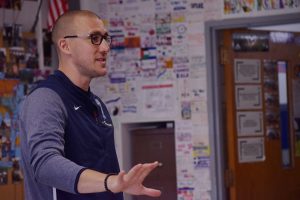
John Camardella
Photo by/Zach Miller
An article by Caroline Matas published in the Harvard News Gazette entitled “Religious Education Through New Eyes” describes the work of John Camardella ’03, a Prospect, IL high school social studies teacher who recently worked to completely redesign the curriculum of the world religions elective he has taught to high school seniors for the past 15 years.
According to the article, most high school religious courses teach a traditions-based model, with a unit on each of the major faiths’ “DERMS”: doctrines, ethics, rituals, myths, and symbols. Camardella had been using this method for years but was recently exposed to a “life-changing” method of teaching religious studies he learned from Harvard Divinity School’s Religious Literacy Project (RLP).
Diane L. Moore, senior scholar and the founding director of the RLP at Harvard Divinity School, has pioneered the field of religious literacy. Rejecting “traditions-based” methods of teaching religion, she proposes that religion should be studied through the lens of cultural studies with the following maxims in mind: 1) religions are internally diverse, 2) religions evolve and change, and 3) religions are culturally embedded.
Moore asked Camardella to serve as an education fellow for the RLP and pilot its pedagogical materials in his classroom; he and the Prospect High School administrators jumped at the chance. Members of the RLP team flew out to visit Prospect over the course of the fall 2017 semester in order to help Camardella prepare to overhaul his curriculum.
While Camardella had the support of the RLP team and his principal, pioneering a change of this magnitude involved a leap of faith.
“There are around five or six people who teach religious studies courses in the Chicagoland area, but everyone else does the standard traditions-based teaching,” Camardella said. “I broke with all of them. We still talk all the time, but I broke with all of them to really put all my chips in this cultural studies basket. I’m pretty much betting my career on it.”
Through adapted materials from the RLP, Camardella had students read case studies that delved into religious groups’ understandings of climate change, gender, minority status, and violence and peace. At the end of each unit, students could pick one subtopic to read and would respond to essay questions about their chosen case study.
“So, we have student choice right away: What are you interested in?” Camardella said. “What you have is a way of assessing students in a healthy and authentic way, but you’re allowing kids to come at the study of religion based on their interests. And what we’ve seen is, kids are now hyper-interested in this because they have so much vested in it.”
Read the full article here.
Great work, John! I know your students are going to benefit greatly from this new method of teaching.
